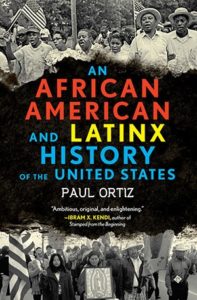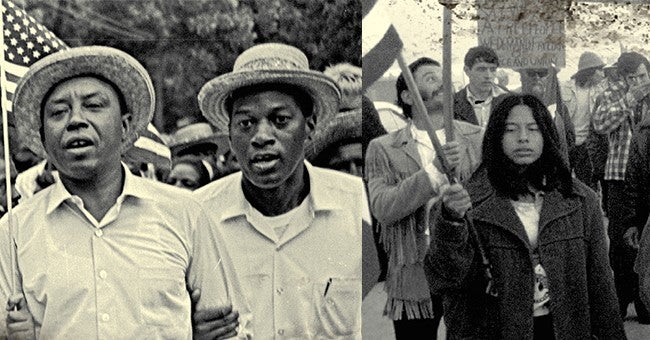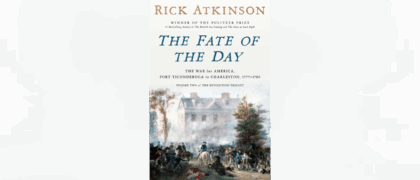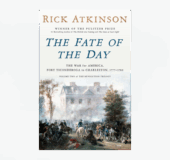The following letter was contributed by Christian Coleman, Digital Marketing Associate at Beacon Press.
We live in a time where a president makes barefaced remarks in speeches that African Americans and Latinx people are prone to violence and corruption. His statements, obviously, pay no respect to the centuries-long history of African Americans and Latinx people organizing together against slavery, oppression, and imperialism to fight for civil rights and human dignity. Not just in the United States, but also worldwide. Luckily, history professor Paul Ortiz provides us with the history we need in his book An African American and Latinx History of the United States. He reminds us, too, that history isn’t done with us. The struggles he writes about continue today in the twenty-first century.
There are five key terms in his book to understand how the inter-sectional Black and Latinx social justice movements have come together, then and now. Ortiz defines them here with examples:
Racial Capitalism
Racial capitalism is an economic system first theorized by Cedric Robinson building upon the work of the radical sociologist Oliver Cromwell Cox. As historian Robin D. G. Kelley noted, Robinson argued that capitalism in its earliest and subsequent iterations was dependent upon and entwined with “slavery, violence, imperialism, and genocide.” Through the twenty-first century, capital continues to generate “racial differences” between sectors of the working class in order to better exploit workers. For example, Mexican American mine workers in Arizona in the twentieth century were paid less wages per hour to do the same work as their white counterparts. In turn, these differences made it more difficult for the working class in the United States to defend its interests against large employers. In An African American and Latinx History of the United States, I use the concept of white business supremacy to denote a system of political power which implements racial capitalism. In chapter six:

“The triumph of white business supremacy relegated African American and Latina/o workers to the bottom of occupational ladders and it meant they had to work for less than their white counterparts. Mario Barrera found that Chicana/o workers in the southwest were subjected to dual (lower) wages in agriculture mining, railroad, transportation, construction, and other industries in the first half of the twentieth century. Likewise, African Americans were shunted into the most menial jobs and were paid less for their work. In 1930, there was not a single African American railroad conductor or banker in Memphis, Tennessee. Black women were often paid 50% less than their white male counterparts in Virginia’s major industries on the eve of the Great Depression. Voter suppression and the weaponized labor relations that transformed the Sunbelt into a haven for cheap labor was one of racial capitalism’s grimmest achievements.”
Emancipatory Internationalism
African Americans developed the idea of emancipatory internationalism in the wake of the American Revolution to emphasize the linkage between freedom struggles in the United States and those in Latin America, the Caribbean, Africa, Europe and elsewhere. This explains why abolitionist Reverend Henry Highland Garnet and others opposed the disbanding of the anti-slavery movement at the Civil War. After all, slavery still existed in countries like Cuba and Brazil. In chapter four:
“African Americans were creating an idea of citizenship that linked national civil rights and international human rights while judging one insufficient without the other. These Fifteenth Amendment commemorations open a window into a new theory and practice of American freedom. Black speakers and their audiences articulated the idea that their individual rights were intimately connected with the rights of oppressed people in Latin America, the Caribbean and other parts of the world. This was an ideolog y based on the harsh experience of seeing slavery and racial capitalism extinguishing liberty everywhere it went. African Americans understood that the United States had torn itself apart due to its allegiance to a theory of profit-based individualism shrouded in slavery. The nation must never again define freedom in such a way as to place property rights above human rights. Furthermore, Americans could not preserve their liberty at home while crushing it abroad as slavery’s imperial advocates had demanded.”
Global South
In this book, the Global South refers primarily to the nations located in Latin America, the Caribbean and Africa—although scholars generally use this term to encompass much of Asia and the Middle East as well. During the post-World War II era, it was common to refer to much of this region as “The Third World.” In this book however, the term Global South takes on a broader, philosophical meaning. The book argues that ideas about freedom, anti-imperialism, and autonomy in the Global South had a decisive impact on US American politics. In chapter five:
“Like José Martí a generation earlier, Bernardo Ruiz Suarez left his native Cuba to write about the United States. Suarez observed, ‘the white race is haughty and domineering everywhere. In those countries where religion, education and other influences have softened the hearts of men, the sentiment of brotherhood tends to level the inequalities and barriers of race and to give reality to that form of society which in Political Science is called Democracy.’ Suarez warned that the United States lacked the ‘sentiment of brotherhood’ altogether: ‘But the race which colonized and still forms the majority of the people of the United States, with its historical antecedents and its degrading record of bloodshed, cannot be classified, in the opinion of an impartial observer, as a democratic race.’
Black and Brown anti-imperialism flourished in the early twentieth century. The refusal of people in Haiti, Nicaragua, Mexico and other nations to submit quietly to US hegemony inspired African Americans trying to ward off racial capitalism’s blows in the United States. Veterans of the war on the government of American banks would have taken exception to a later generation of scholars who characterized the United States as ‘isolationist’ or democratic. The insurgent citizenry of the Americas who faced the ‘colossus of the North’ would have scoffed at the idea that the United States was not an empire. The opponents of the US military invasions of the early twentieth century demanded that the United States be held accountable for its overseas depredations. Instead historians shrouded the country’s history in a veil of innocence and exceptionalism which has undermined the nation’s ability to reform itself to this day. It cannot be said that scholars lacked sources that could have guided them to the truth. Bernardo Suarez, whose nation had dealt with US power for decades, spoke for many in the Global South in 1922 when he concluded, ‘No matter what is said to the contrary, and there is much truth that may be said, the United States of America have by no means lived up to their professed abhorrence of autocracy and aggressive imperialism in their international affairs.’”
International Solidarity
Like all great ideas, international solidarity was an idea that came out of the mass insurgencies and social movements against slavery, and later, Jim Crow. African Americans came to understand that the battles that citizens of Mexico and other nations in the Global South bore a resemblance—and a real connection—to the struggle against white business supremacy in the United States. In chapter five:
“Just as the general strike against slavery prepared the way for the expansive thinking that produced the Cuban solidarity movement of the 1870s, Black resistance to Jim Crow generated creative possibilities of a revived anti-imperialism in the early twentieth century. African American communities launched sustained boycotts of segregated streetcars and transit in the South, took up arms to defend their communities against lynching, and agitated for a return of the ballot. Community organizers built vital new institutions such as the Universal Negro Improvement Association (UNIA) as well as the NAACP which launched national campaigns against debt peonage and voter suppression. Of course, these campaigns took place on a profoundly unequal terrain that placed Black citizens in direct conflict with federal and state authorities as well as corporations that drew their life blood from disenfranchised labor. Indeed, this insider knowledge of actually-existing capitalism was what gave Black critiques of US economic imperialism their special force. William Jones mounted an attack on US State Department interference with land reforms in Mexico by observing that, ‘Those who have studied the Mexican problem will be inclined to believe that the whole sudden outburst on the part of the State Department was inspired by that group of capitalists in this country who have been for some time displeased with recently passed Mexican agrarian laws.” Jones accused the US of falsely claiming that American citizens’ lives were endangered in Mexico in order to abrogate revolutionary land reform measures.
They were so framed as to make it possible for actual toilers on the soil to compel foreign owners to dispose of their holdings. Americans call this confiscation when practiced in Mexico, but patriotism when exacted as California did against the Japs. But some human beings will always seek a way to keep other human beings toiling for them. You wonder why, with so much untilled land in this country, with our farmers begging for capital, and industry lagging, we have so much money to invest in Mexican farms.”
Hemispheric Liberation Movement
The idea of a hemispheric liberation movement was expressed by generations of revolutionaries in Haiti, Mexico, the United States and other countries in the early nineteenth century and manifests itself in key events such as the Mexican War of Independence when José María Morelos and other Mexican revolutionaries reached out to the United States for support against European colonialism. We also see evidence of ideas of a hemispheric-wide liberation movement expressed by enslaved African Americans who strike for their liberty in Gabriel’s Rebellion and other slave revolts with the idea of linking up with revolutionaries in Haiti and the Caribbean. In chapter two:
“Mexicans, African Americans and their abolitionist allies expressed very different views of the Mexican War of Independence than those held by John Quincy Adams. Those people who embraced emancipatory internationalism conceived of a hemispheric liberation movement that would not be tied to nationality or constrained by boundaries. They also knew that slavery’s relentless cycle of growth would destroy democracy. If ‘additional territory had been denied to the slavery of the old slave States,’ The National Era noted, ‘it would have been at least in process of abolition. But it was allowed to propagate itself, and, in so doing, it gathered new life. Not only were the new States, formed out of the territory originally possessed by the Union, given up to its ravages, but Florida, and the immense territory of Louisiana, were opened to it.’ The abolitionist paper grieved, ‘Why deceive ourselves? The establishment of slavery in California, in New Mexico, or a part of it, and throughout Texas, will invest the slave-holding class with a power, from which there can be no escape.’
Early African American newspapers like the Colored American united Black struggles with anti-colonial movements in the Global South. The newspaper’s editors broadened the scope and scale of the anti-slavery movement. These types of analyses emphasized that the question of liberty or death was not a question of Black vs. white. The roles of Africans, Indigenous people, and mixed-race people in hemispheric-wide resistance movements were re-imagined….”
In the twentieth century, the Haitian and Mexican delegations at the Inter-American Conference on Problems of War and Peace held in Chapultepec Mexico, re-introduce the idea of a hemispheric conception of freedom by arguing that post-war peace in the Americas will depend on not only equality between nations of the Americas but also equality within the nations as well, thus re-joining the struggle against racial oppression to national liberation. In chapter seven:
“The Final Act of Chapultepec now carried with it the force of law in the United States. Texas socialist Harold Preece, a frequent contributor for African American newspapers, was jubilant. ‘I’m not going overboard when I agree with leading diplomats in Mexico City interpreting the Chapultepec declaration for inter-American cooperation and defense as ‘the greatest joint document of democratic principles and hemispheric unity ever signed by the American nation.’ Preece stated that Chapultepec ‘means that Negroid nations like Haiti, the Dominican Republic, Cuba and Brazil, stand on the same plane with predominantly white nations like the United States and Chile.’ Most importantly, Harold Preece asserted, the Act of Chapultepec slammed the legal brakes on US military intervention in Latin America, and threatened the power of government of American banks to control the people of the Global South:
This time, the big stick is going to be wielded by the peoples of the America against all those who would disturb the peace and prosperity of the Americas. It’s going to hit Argentina, excluded from a seat in the conference, unless Argentina stops acting like Alabama and starts acting like folks you can invite to sit down at your table.”
Those who tried to live the ideals of anti-imperialism as a way of life have much to teach us. While many of today’s politicians want to build barrier walls to divide nations, the individuals and social movements we have studied struggled to build democratic movements to bring the hemisphere’s people together. The United States continues to deny citizenship to many of this nation’s hardest workers. In contrast, the advocates of emancipatory internationalism envisioned a new kind of citizenship which spanned the entire Americas. While “the government of American banks” pushed the US to become the police officer of the Global South, African Americans from Baltimore to San Francisco opted for international solidarity.
This nation’s history beautifully echoes Elizabeth Martinez’s insight: “We can choose to believe the destiny of the United States is still manifest: global domination. Or we can see a transformative vision that carries us forward, not backward. We can seek an origin narrative that lays the groundwork for a multicultural identity centered on the goals of social equity and democracy. We do have choices.”
Paul Ortiz is an associate professor of history and the director of the Samuel Proctor Oral History Program at the University of Florida. He is the author of Emancipation Betrayed: The Hidden History of Black Organizing and White Violence from Reconstruction to the Bloody Election of 1920 and coeditor of the oral history Remembering Jim Crow: African Americans Tell About Life in the Segregated South. He lives in Gainesville, Florida.
Christian Coleman is the Digital Marketing Associate at Beacon Press. Follow him on Twitter at @coleman_II.






